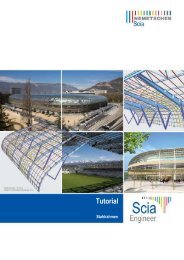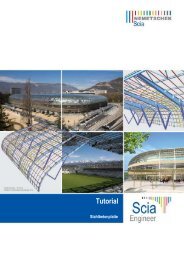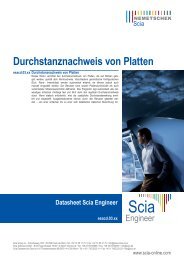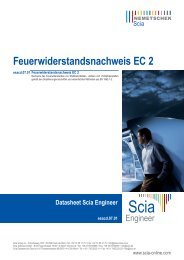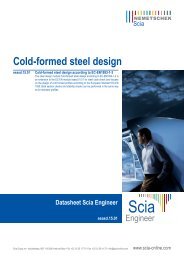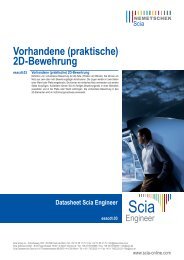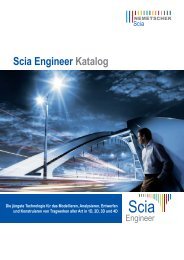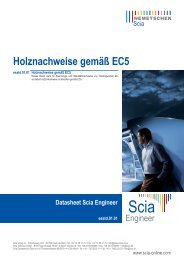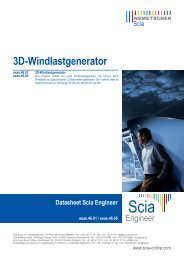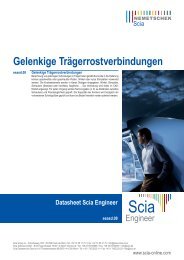Advanced Package Training Scaffolding 2011.1 - Scia-Software GbR
Advanced Package Training Scaffolding 2011.1 - Scia-Software GbR
Advanced Package Training Scaffolding 2011.1 - Scia-Software GbR
Create successful ePaper yourself
Turn your PDF publications into a flip-book with our unique Google optimized e-Paper software.
10<br />
<strong>Advanced</strong> <strong>Training</strong><br />
According to code EN12811-1, the connection column - column can be considered rigid<br />
in the modelling<br />
A hinge will not be entered at the extremities on the standard<br />
Standard – Ledger and Standard – Guardrail connections<br />
- y direction: 0,10 MNm/rad<br />
- z direction: 0,005 MNm/rad<br />
These rigidities are obtained from data from the supplier. In this case, the rigidity for the y direction is<br />
taken from the supplier and a smaller value is taken for the z direction. Of course, this is not a<br />
correct method. Both should be obtained from data from the supplier.<br />
Standard – Toeboard and Ledger – Floor board connections<br />
- y direction: Hinged<br />
- z direction: Rigid<br />
Standard – Bracing connections<br />
Summary:<br />
SUPPORTS<br />
- y direction: Hinged<br />
- z direction: Rigid<br />
As a summary, the following rigidities can be entered in <strong>Scia</strong> Engineer:<br />
Standard-ledger: y direction: 0.10 MNm/rad<br />
z direction: 0.005 MNm/rad<br />
Standard-guardrail: y direction: 0.10 MNm/rad<br />
z direction: 0.005 MNm/rad<br />
Standard-bracing: y direction: Free<br />
z direction: Rigid<br />
Standard-toeboard: y direction: Free<br />
z direction: Rigid<br />
Ledger-floor board: y direction: Free<br />
z direction: Rigid<br />
There are two types of supports: the base jacks at the bottom and the anchorages in the wall.<br />
For the base jacks, translations in all directions are fixed (Translations X, Y and Z fixed). For the<br />
anchorages, only the translations according to the x and y direction are fixed (Translations X and Y<br />
fixed).<br />
The anchorages are introduced according to the anchorage scheme: from 4m high, every standard<br />
has to be anchored every 4 m upward. Over 20 m high, this needs to be performed every 2 m upward.



